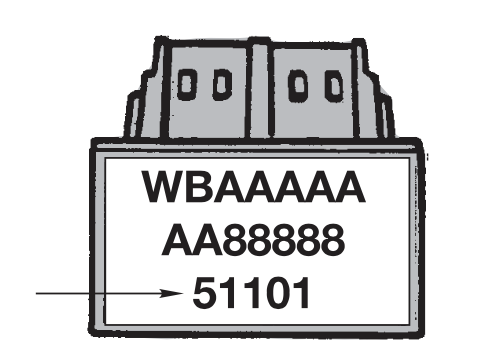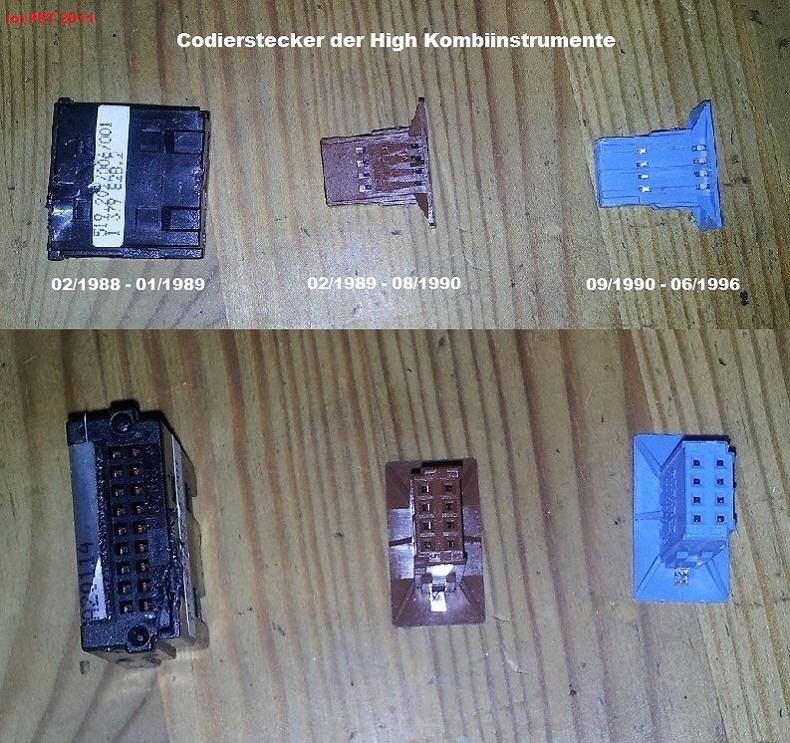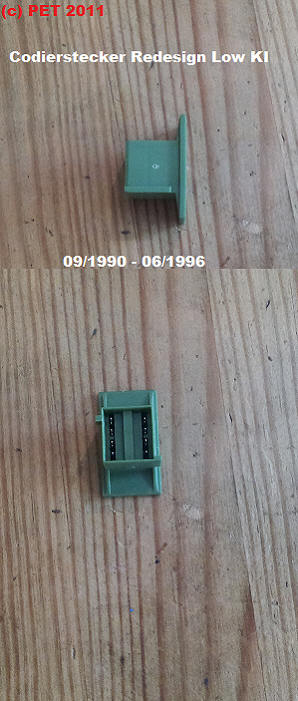- 0xdurakiCoding Plugs
A coding plug is a mechanically keyed or electronically coded device/plug, that can open or bridge circuits in a particular component, therefore allowing it to operate differently dependent on the type of plug installed.
BMW used a mechanical coding plug which simply opened or bridged circuits to assign market specific data to the instrument cluster of the E23, E24, E28 and E30 vehicles. With the introduction of the E32 in 1988 and the E34 in 1989, electronic coding plugs were utilized in the instrument cluster.
The change to an electronic coding plug which allowed market specific data to be assigned to the instrument cluster also contained Non-Volatile Random Access Memory (NV-RAM), which provided an ability to retain vehicle specific data in the plug such as:
- Vehicle Identification Number (VIN)
- Accumulated Total Mileage
- Service Indicator (SI) Information
- Coding Plug Number
- Fuel Tank Size data
- Other Necessary Data
By using a plug that is able to store data, the instrument cluster can be replaced without loosing vehicle mileage, unless the coding plug is damaged.
With the introduction of vehicles like the E31 and E38 the instrument cluster no longer utilizes a coding plug since it receives most of its input signals directly from a control module, EKM (E31) or IKE (E38), this allows vehicle data to be directly stored in the con- trol module and the instrument cluster is no longer coded. For these vehicles and newer models, market specific data is stored in the control module (EKM or IKE). By coding these modules by way of ZCS coding (refer to ZCS coding) market specific data is assigned/released to the control module.
Coding Plug: Intergrated Circuit (IC) Details
The user @kfister posted in 2007 on bimmerboard.com forum with all the messages he manage to dump from the BMW E34 Coding Plug ROM // EEPROM. He also noted that the Code Plug has copies of frame number, ZCS key for storage, mileage, and bitmapped options (shown below).
Coding Plug EEPROM Dump
CODE_NR_2 e34/e32 CODE_NR_3 e34/e32 SIA_TEMP_FAKTOR wert_01 GETRIEBE_SIA_WEG 100.000_km GETRIEBE_SIA_TAGE 1825_tage DATA_VALID datensatz_gueltig TANKGEBER tauchrohrgeber IB_EIN_ENTRIEGELN nicht_aktiv GETRIEBE handschaltung PARK/NEUTRAL_EINGANG nicht_aktiv MRA_TAKTUNG nicht_aktiv SCHLUPFSCHWELLENOFFSET nicht_aktiv SCHLUPFBANDMODIFIKATION nicht_aktiv AMR_TYP typ_3 BMR_TYP typ_2 K_ZAHL_WEG 4574_imp/km STEIGUNG_EINSPRITZ_KENNL m60b40 ZYLINDER_ZAHL 8_zylinder MOTOR_ART benziner MOTOR_FAKTOR 4_imp/umdrehung SPRACHE englisch_us ZEIT_EINHEIT 12_stunden TEMPERATUR_EINHEIT grad_f WEGSTRECKE_EINHEIT mls ABSCHALTDREHZAHL_ANLASSER 8_zylinder_benziner ZEITDAUER_BIS_ABSCHALTUNG benziner SCHALT_KRITERIUM_EWS_3 8_zylinder_benziner EWS_3_SCHNITTSTELLE nicht_aktiv CODE_NR_1 e34/e32 CODE_NR_4 e34/e32 CODE_NR_5 e34/e32 GURTWARNUNG_GONG nicht_aktiv LAENDERVARIANTE us TANK_KENNLINIE 81_l_stahl TANK_GAS_KENNLINIE kennlinie_01 TANK_GAS_KENNLINIE_WINKEL kennlinie_01 SIA_GRENZE_INSPEKTION 32.200_km SIA_GRENZDREHZAHL 4500_u/min SIA_GRENZE_ZEIT 0_tage OELSERVICE_ANZAHL 2_service WARNUNG_GESCHW_LIMIT nicht_aktiv ANZEIGE_KVA/OEL kva TEMPERATUR_KENNLINIE kennlinie_03 SCHWELLE_UEBERDREHZAHL 7200_u/min DZM_SKALA_ENDWERT 7000_upm_4_imp/kwu AUSTAUSCHPUNKT nicht_aktiv OFFSET_GESAMTWEGSTRECKE 0_km TACHO_SKALA_ENDWERT 160_mph_ece/us TEMPERATUR_ANZEIGEWINKEL kennlinie_02 TACHO_SKALA_ENDWERT_KOMPL 160_mph_ece/us K_ZAHL 4534_imp/km K_ZAHL_RED 4534_imp/km LICHTWARNUNG aktiv REST_LITER_FAKTOR 16_l SIA_ANZEIGE aktiv SIA_ANZEIGEDAUER 10_sec SIA_DZ_FAKTOR wert_01 SIA_ROT/GELB_SEGMENTE aus_mit_gruen TACHO_SKALA_ENDWERT_RED 240_km/h TANK_KENNLINIE_WINKEL 81_l_stahl TEMPERATUR_KENNL_VERSCHL kennlinie_02 WARNUNG_GESCHW_LIMIT_2 nicht_aktiv WARNUNG_GESCHW_LIMIT_RED nicht_aktiv CHECK_CONTROL_VERSION us EINSPRITZART vollbank_1ti_signal GETRIEBE_ART keine_anzeige K_ZAHL_BC 4534_imp/km K_ZAHL_KOMPL 4534_imp/km KOMBI_ART high_kombi LAENDER_EINHEITEN us TANK_KENNLINIE_BC 81_l_stahl VENTILVERZUG_FAKTOR_A 0 VENTILVERZUG_FAKTOR_B 0 VERBRAUCH_EINHEIT mpg_us WARNUNG_GESCHW_LIM_KOMPL nicht_aktiv WARNUNG_UEBERTEMPERATUR 130_grad_celsius EDC_KENNFELD dv200 M21_DIESEL nicht_aktiv M40_ODER_M50 nicht_aktiv M51_DIESEL nicht_aktiv TEMPERATURFUEHLER innenfuehler ZYLINDER_4_BENZIN nicht_aktiv ZYLINDER_6_BENZIN nicht_aktivCoding Plug Identification
Each coding plug features a stored 5-digit numerical code that varies between model/equipment, etc. The code can be read out through the instrument cluster display by pressing the odometer reset button and turning the ignition switch to KL R. The coding plug number will be display in the instrument cluster matrix.
 BMW Coding Plug Identification
BMW Coding Plug IdentificationCoding Plug Overview
Since the introduction of the E32 several versions of instrument cluster coding plugs have been introduced, this section will provide an overview of the different versions, plus provide identification and coding information.
The E32/E34 Instrument cluster coding plugs progressed through three variations of design.
- MY. 11/88-02/89
The original E32/E34 instrument cluster coding plug was installed in the wiring harness connector (X16) which plugged into the instrument cluster. This plug contained all of the vehicle specific coding data for the instrument cluster and retained accumulated mileage and service interval information.
- MY. 02/89-09/91
The E32/E34 instrument cluster and coding plug were redesigned in Feb. ‘89. As a result of this redesign the coding plug became an external component and plugged directly into the back of the instrument cluster, no longer part of the X16 connector.
- MY 09/90 [revision]
In 9/90 the cluster was slightly redesigned again to address changes in the fuel gauge and some minor physical changes. The electronics of the cluster as well as the coding plug were upgraded considerably.
The coding plug and the instrument cluster are not compatible with the earlier redesign. The printed circuit board and the coding plug are colored blue for distinction over the components of the earlier redesigned cluster.
The new blue coding plug is also keyed differently to prevent unintentional exchange with the earlier coding plug.
- MY 09/91 and above
After 9/91 production, the instrument cluster coding plug can be coded using the ZCS function within CIP by selecting the specific module via the DISplus/GT1/SSS . The physical characteristics of the coding plug did not change.
A replacement uncoded coding plug must be coded after installa- tion into the instrument cluster, refer to ZCS coding section in this manual.
Expand for Photos (Images)


References